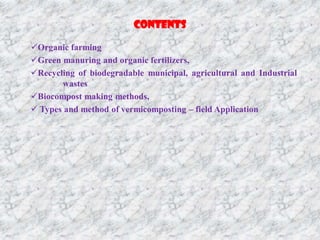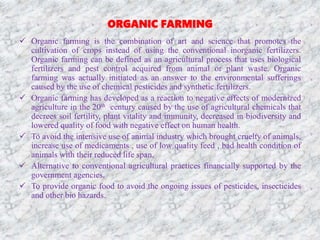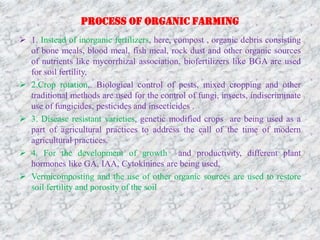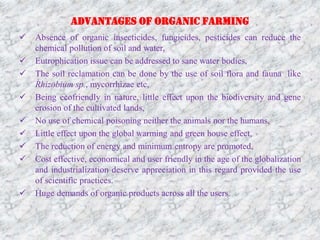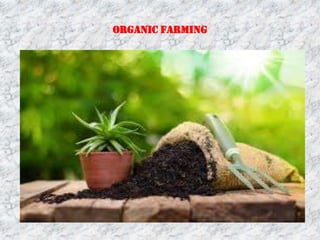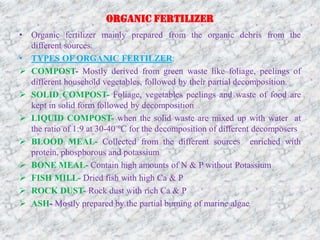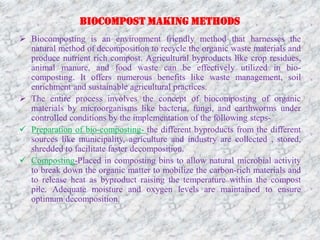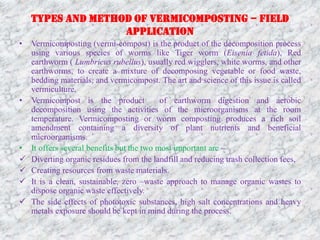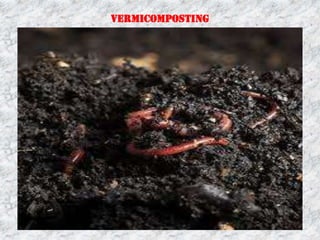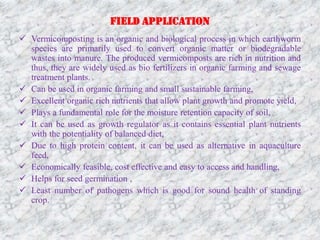Organic Farming and its importance today in the context of soil health and organic food production.
- 1. ORGANIC FARMING • A PRESENTATION BY • Dr. N. Sannigrahi, • Associate Professor, • Department of Botany, • Nistarini College, Purulia, • D.B. Road, Purulia (W.B) • India, 723101
- 2. CONTENTS Organic farming Green manuring and organic fertilizers, Recycling of biodegradable municipal, agricultural and Industrial wastes Biocompost making methods, Types and method of vermicomposting – field Application
- 4. ORGANIC FARMING Organic farming is the combination of art and science that promotes the cultivation of crops instead of using the conventional inorganic fertilizers. Organic farming can be defined as an agricultural process that uses biological fertilizers and pest control acquired from animal or plant waste. Organic farming was actually initiated as an answer to the environmental sufferings caused by the use of chemical pesticides and synthetic fertilizers. Organic farming has developed as a reaction to negative effects of modernized agriculture in the 20th century caused by the use of agricultural chemicals that decrees soil fertility, plant vitality and immunity, decreased in biodiversity and lowered quality of food with negative effect on human health. To avoid the intensive use of animal industry which brought cruelty of animals, increase use of medicaments , use of low quality feed , bad health condition of animals with their reduced life span, Alternative to conventional agricultural practices financially supported by the government agencies, To provide organic food to avoid the ongoing issues of pesticides, insecticides and other bio hazards.
- 5. PROCESS OF ORGANIC FARMING 1. Instead of inorganic fertilizers, here, compost , organic debris consisting of bone meals, blood meal, fish meal, rock dust and other organic sources of nutrients like mycorrhizal association, biofertilizers like BGA are used for soil fertility, 2.Crop rotation,. Biological control of pests, mixed cropping and other traditional methods are used for the control of fungi, insects, indiscriminate use of fungicides, pesticides and insecticides . 3. Disease resistant varieties, genetic modified crops are being used as a part of agricultural practices to address the call of the time of modern agricultural practices. 4. For the development of growth and productivity, different plant hormones like GA, IAA, Cytokinines are being used, Vermicomposting and the use of other organic sources are used to restore soil fertility and porosity of the soil
- 6. ADVANTAGES OF ORGANIC FARMING Absence of organic insecticides, fungicides, pesticides can reduce the chemical pollution of soil and water, Eutrophication issue can be addressed to sane water bodies, The soil reclamation can be done by the use of soil flora and fauna like Rhizobium sp., mycorrhizae etc, Being ecofriendly in nature, little effect upon the biodiversity and gene erosion of the cultivated lands, No use of chemical poisoning neither the animals nor the humans, Little effect upon the global warming and green house effect, The reduction of energy and minimum entropy are promoted, Cost effective, economical and user friendly in the age of the globalization and industrialization deserve appreciation in this regard provided the use of scientific practices. Huge demands of organic products across all the users.
- 7. DISADVANTAGES OF ORGANIC FARMING Time consuming and labor intensive that can promotes the disease dissemination if the infection starts, It can increase the cost price of the production , The chance of yield is less and it can cause the increase of the food stuffs, The proper scientific knowledge must be disseminated among the targets groups of farmers , otherwise, it can develop serious problem, Difficult to address the need of the quantity of food to address malnutrition and hunger in the context of global population, Intensive agricultural practices need more labor in the age of agricultural automation, Crops are easily susceptible to diseases, Traditional methods have lot of hidden insecurity and risk factors. Markets of organic food are still inaccessible to many small, scale farmers and the excess production to sell in the local markets without certification.
- 8. GREEN MANURING AND ORGANIC FERTILIZERS Sustainable soil fertility with zero side effect is very important nowadays. When the soil fertility is restored by the use of green plants directly following certain protocols are treated as green manuring. About 300 B.C, the process was first used in Greece and it came into the use by the Chinese in the later parent as far as information received. The plants used for this purpose must be fast growing, Green foliage quantity must be considered before selection, The root systems of these plants must have good network, The plants must possesses degree of tolerance especially in the sterile and unfertile land despite the issues, The plants must have first decomposition rate for easy mixing up with the soil where these are to grown and nourished, Mostly two types- Non-legume crops like Brassica sp, Zea mays, Raphanus sativus etc. and legumes plants like Pisum sativum, Phaseolus auretus, Melilotus alba etc.
- 9. ADVANTAGES & DISADVANTAGES OF ORGANIC FARMING It can substantially supply organic contents and nitrogen into the soil, It controls soil erosion, It reduces the intake of inorganic fertilizers, Rear biodiversity, It offers the nutrients to the soil formers micro flora and fauna, It maintains P, Ca into the soil, The legumes can maintain the nitrogen content of the soil and makes the avenues of the supply of nitrogen and its compounds to the non-legume crops in the subsequent years, The cost of production is partially reduced • DISADVANTAGES The chance of weeds and its population is subjected to increase due to this practices, The aggression of insects and pests is increased due to green manure application, It produces allelopathic effect that becomes detrimental to the other standing crops in the subsequent time.
- 10. ORGANIC FARMING
- 11. ORGANIC FERTILIZER • Organic fertilizer mainly prepared from the organic debris from the different sources. • TYPES OF ORGANIC FERTILZER: COMPOST- Mostly derived from green waste like foliage, peelings of different household vegetables, followed by their partial decomposition. SOLID COMPOST- Foliage, vegetables peelings and waste of food are kept in solid form followed by decomposition LIQUID COMPOST- when the solid waste are mixed up with water at the ratio of 1:9 at 30-40 ℃ for the decomposition of different decomposers BLOOD MEAL- Collected from the different sources enriched with protein, phosphorous and potassium BONE MEAL- Contain high amounts of N & P without Potassium FISH MILL- Dried fish with high Ca & P ROCK DUST- Rock dust with rich Ca & P ASH- Mostly prepared by the partial burning of marine algae
- 12. ADVANTAGES OF ORGANIC FERTILIZER Easy to produce and handle for the sake of convenience; In USA, 82% household uses organic fertilizer, This fertilizer is enriched with Carbon which is no longer uses in inorganic fertilizer; it is a carbon supplement to plants, It helps the decomposition of the plant and animal debris, It is mostly ecofriendly for the sake of environmental reclamation, The use of organic fertilizer neither create any hazards to the environment nor the target groups, It is cost effective and market friendly, The minerals contents of the organic fertilizer undergo slow but steady decomposition which is good enough for the soil health. DISADVANTAGES It does not enable to maintain the proportion of N, P & K in the soil, It is time consuming, does not address immediate needs, It may create nuisance of dour in the environment where the site for production is chosen.
- 13. RECYCLING OF BIODEGRADABLE MUNICIPAL, AGRICULTURAL AND INDUSTRIAL WASTES Waste is a byproduct of population increase, urbanization and economic growth, agricultural demand and industrial development. This will deteriorate the already strained environment and climate situation. There is an urgent need for methods to recycle solid waste. Municipal solid waste is one of the most significant byproducts of urban life style and is growing faster than the urbanization, Municipal solid waste problem has been aggravated by the issues of agricultural solid waste and industrial solid waste, The municipal waste can be categorized into two groups- Green Waste- Mostly foliage, debris from household activities, bone meal, blood meal, fish meal and others, Brown waste- Clothes, newspaper, death and debris of plants, straw, saw dust etc.
- 14. BIOCOMPOST MAKING METHODS Biocomposting is an environment friendly method that harnesses the natural method of decomposition to recycle the organic waste materials and produce nutrient rich compost. Agricultural byproducts like crop residues, animal manure, and food waste can be effectively utilized in bio- composting. It offers numerous benefits like waste management, soil enrichment and sustainable agricultural practices. The entire process involves the concept of biocomposting of organic materials by microorganisms like bacteria, fungi, and earthworms under controlled conditions by the implementation of the following steps- Preparation of bio-composting- the different byproducts from the different sources like municipality, agriculture and industry are collected , stored, shredded to facilitate faster decomposition. Composting-Placed in composting bins to allow natural microbial activity to break down the organic matter to mobilize the carbon-rich materials and to release heat as byproduct raising the temperature within the compost pile. Adequate moisture and oxygen levels are maintained to ensure optimum decomposition.
- 15. BIOCOMPOST MAKING METHODS Maturation- After the initial decomposition, the compost undergoes a maturation period where it is left to stabilize and undergo further microbial activity. The duration of the stage varies depending upon the composting materials and the desired quality of the compost. Regular turning or mixing of the composite pile is often necessary to enhance the microbial growth and further desired decomposition Application of biocompost- Once the compost has matured, it can be used to soil amendment to enhance soil fertility and structure . It can be applied to agricultural fields, gardens , landscape projects to improve nutrient availability, water retention and over all the health of the soil and its growth. Thus biocomposting offers a multiple practices including nutrient recycling, soil enrichment, carbon sequestration and cost effectiveness to the multiple sectors including agriculture, horticulture and gardening and landscape beauty. Embracing biocomposting as a viable solution to contribute to building a more sustainable and resilient future.
- 16. TYPES AND METHOD OF VERMICOMPOSTING – FIELD APPLICATION • Vermicomposting (vermi-compost) is the product of the decomposition process using various species of worms like Tiger worm (Eisenia fetida), Red earthworm ( Lumbricus rubellus), usually red wigglers, white worms, and other earthworms, to create a mixture of decomposing vegetable or food waste, bedding materials, and vermicompost. The art and science of this issue is called vermiculture. • Vermicompost is the product of earthworm digestion and aerobic decomposition using the activities of the microorganisms at the room temperature. Vermicomposting or worm composting produces a rich soil amendment containing a diversity of plant nutrients and beneficial microorganisms. • It offers several benefits but the two most important are – Diverting organic residues from the landfill and reducing trash collection fees, Creating resources from waste materials. It is a clean, sustainable, zero –waste approach to manage organic wastes to dispose organic waste effectively. The side effects of phototoxic substances, high salt concentrations and heavy metals exposure should be kept in mind during the process.
- 17. VERMICOMPOSTING
- 18. METHOD One large tank should be used either made up of plastic or concrete, Unused the organic debris of plants and other household organic debris to be dried 8-12 days in the sunlight and made small pieces, 2-3 inch layer of sand or soil is filled up at the base of the tank, Biodegradable compost are covered with cow dung slurry, To prevent the direct exposure of sunlight or rainfall, the tank should be covered either by polythin bags or structure with straw, Earthworms are to mixed up at the 150 earthworms per liter density of the biodegradable wastes, The temperature of the entire set to be kept at 35℃ approximately, About 60 days, the number of the inoculated earthworms will be doubled, The internal temperature must not be too much and the entire set to made free from insects , ants, snake, cobwebs etc for the purity of the vermicomposting to be prepared thereon, After 22-32 days, the vermicomposting to be collected and prepared for marketing.
- 19. FIELD APPLICATION Vermicomposting is an organic and biological process in which earthworm species are primarily used to convert organic matter or biodegradable wastes into manure. The produced vermicomposts are rich in nutrition and thus, they are widely used as bio fertilizers in organic farming and sewage treatment plants. Can be used in organic farming and small sustainable farming, Excellent organic rich nutrients that allow plant growth and promote yield, Plays a fundamental role for the moisture retention capacity of soil, It can be used as growth regulator as it contains essential plant nutrients with the potentiality of balanced diet, Due to high protein content, it can be used as alternative in aquaculture feed, Economically feasible, cost effective and easy to access and handling, Helps for seed germination , Least number of pathogens which is good for sound health of standing crop.
- 20. “I am In Love wIth thIs green earth”
- 21. THANKS FORYOURVISIT • References: I. A Textbook of Botany- Hait, Bhattacharyya, Ghosh II. A Manual of Seed Production and Certification- CIKS III. Snatak Udbhidvidya Vol. III- Sikadar , Sen & Giri IV. Soil Microbiology- N.S. Subba Rao, V. Agricultural Microbiology- G. Rangaswami, VI. Google for images, VII. Different WebPages for information. • Disclaimer: This PPT has been made to enrich free online study resources to reach the unreached without any pleasure of financial interest.

